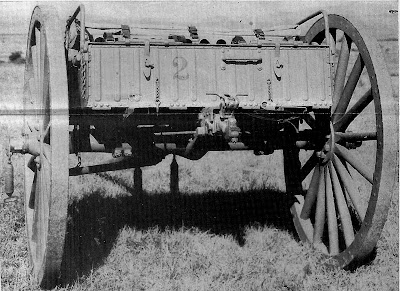ANCILLARY HORSE-DRAWN FIELD ARTILLERY
VEHICLES and EQUIPMENT
From Field Artillery Matériel (Elementary), Field Artillery School, 1932
75mm Gun - Caisson Limber, Model of 1918: The 75mm Gun - Caisson Limber, Model of 1918 carried 18 round of 75mm ammunition and three oil cans shaped like rounds to fit the spaces. The six-horse team was attached to the limber and towed either the 75mm Field Gun, Model of 1897 (French), or the Caisson, Model of 1918. In Field Artillery three cannoneers rode each limber. Three collapsible canvas watering buckets were carried beneath the seats. Note the lantern in its holder in front of the limber box.


75mm Caisson, Model of 1918: The 75mm Caisson, Model of 1918 was towed by a Gun - Caisson Limber, Model of 1918, and six horses. The caisson carried 70 rounds of ammunition and the fuze setter. In light artillery three or four cannoneers rode the caisson. In firing position the caisson was parked next to the gun and the crew prepared ammunition, set fuzes and passed the ammunition to the gun crew. The door on the ammunition bay and the apron beneath the axle serve to protect the crew from small arms fire and small fragments when in firing position. Note that this example has hard rubber tires. I do not know when or why they were issued with hard rubber tires.
 Breast Reel: The Breast Reel was used to lay or retrieve 600 feet of communications wire, and was used by the Battery Detail, today’s Forward Observer Party, to connect the Battery Commander to the Battery Detail Signal Operators to relay target data to the Battery Signal Operator with the Battery Executive Officer in charge of the guns.
Breast Reel: The Breast Reel was used to lay or retrieve 600 feet of communications wire, and was used by the Battery Detail, today’s Forward Observer Party, to connect the Battery Commander to the Battery Detail Signal Operators to relay target data to the Battery Signal Operator with the Battery Executive Officer in charge of the guns.
Battery Reel, Model of 1917: This single equipment, pulled by four horses, carried 1.7 miles of twisted pair field communications wire. The equipment reel is ground powered and is used to pay out or retrieve field communications wire. The chest holds communications equipment. This equipment carried the signal wire from the Battery Detail Signal Operator to the Signal Operator with the Battery Executive Officer in charge of the guns.


Artillery Reel, Model of 1909 (M1): The Artillery Reel, Model of 1909 (M1) and the Artillery Cart, Model of 1918 formed one vehicle and were pulled by four horses. The reel was capable of laying or retrieving 1.7 miles of twisted pair field communications wire on each drum. This could be laid as one 3.2 mile wire or two 1.7 mile wires.

 Artillery Cart, Model of 1918: The Artillery Cart, Model of 1918, was pulled by the Artillery Reel, Model of 1909 (M1) and carried various artillery instruments and had attachments on the exterior for the attachment of an observation tower.
Artillery Cart, Model of 1918: The Artillery Cart, Model of 1918, was pulled by the Artillery Reel, Model of 1909 (M1) and carried various artillery instruments and had attachments on the exterior for the attachment of an observation tower. Forge Limber, Model of 1902: The Forge Limber was pulled by six horses and towed the Battery and Store Wagon, Model of 1917. It was same general exterior configuration as the Gun-Caisson Limber, but the lid was hinged on the top and was divided into compartments for the field forge, anvil, and other horseshoeing and mechanics’ tools.
Forge Limber, Model of 1902: The Forge Limber was pulled by six horses and towed the Battery and Store Wagon, Model of 1917. It was same general exterior configuration as the Gun-Caisson Limber, but the lid was hinged on the top and was divided into compartments for the field forge, anvil, and other horseshoeing and mechanics’ tools.
Battery and Store Wagon, Model of 1917: The Battery and Store Wagon, Model of 1917, was pulled by six horses and Forge Limber, Model of 1902. The Battery and Store Wagon carried the wheelwright’s tools, carpenter tools, saddler’s tools and various spare harness and bulk leather, and wheel spokes and felloes. In the rear were compartments for carrying recoil oil, lubricating oil and kerosene. Mounts were provided on the sides for carrying spare wheels and a spare limber pole was carried beneath the frame.




 155mm Howitzer, Model of 1918 (Schneider): The 155mm Howitzer, Model of 1918 (Schneider) was the American manufactured version of the French piece. Its shield is straight in profile and mounted at a slant.
155mm Howitzer, Model of 1918 (Schneider): The 155mm Howitzer, Model of 1918 (Schneider) was the American manufactured version of the French piece. Its shield is straight in profile and mounted at a slant.





 Disposition of harness in field for one half of the section on the limber tongue.
Disposition of harness in field for one half of the section on the limber tongue.




 Off Side
Off Side







